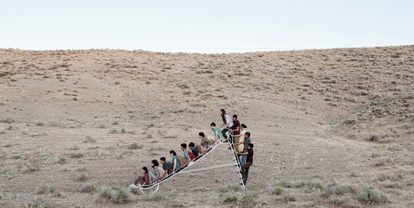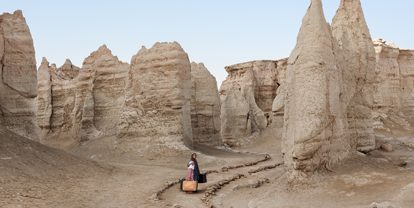Gohar Dashti 2015
Gohar Dashti
October 30 — November 11, 2015
From the Dust of this Desert
I lived more vagrant than the wind,
In a land where no plant grows.
O, quick strutter!
I cripple because of the roughness of your road…
Ahmad Shamloo
The key point in Gohar Dashti’s recent series is the culture/nature dichotomy. The virgin land of nature stands against a culture intolerant of modernity; societies that their members are exiled to a wilderness, a desolation, a far away, traceless land; to the time before culture was formed, to a primal state. In “Iran, Untitled”, the nature, having had enough of all the rational achievements and scientific developments, and thus turned to a haven and a refuge, appears as a dystopia: another dimension; a world parallel to our contemporary world; nothingness. With that in the background, in the midst of every frame, some people are doing things that seem like everyday activities: funeral and wedding, soldiering and migration. But looking deeper, one sees the ironic, multilateral and absurd nature of their activities: the vanity of deeds that happen in a closed place, like a capped bottle, a metaphor for a dire situation, even in a desert, where there is normally freedom of movement, but in fact the glass walls are obstacles to this movement. The freedom of movement stands out in stark contrast against the limitations and confinements and the vastness in contrast to compactness and entanglement. What we see is not what is actually there, and that is the bitter irony of the situation. People are in limbo—an in-between place, like Dante’s first stage of Inferno, where people are stuck not because of sinfulness, but unbelief and only here, they are stuck forever, hopelessly wishing. Works of Dashti, as always, have a symbolic and theatrical side to them. In each image, human subjects are doing the same thing: social structures and frameworks that will lead to uniformity, repetition and eventually the suppression of individuality in favor of integration and the collective. The artist’s nature of choice is the wilderness: a metaphor for a place where no plant grows, and being lost in it can be deadly. In “Stateless”, the artist broadens the thematic scope: wandering and vagrancy in the life of contemporary, middle-eastern man, peculiarities of the collective experience of migration and immigration; history of societies that are not able to stay and resist, and therefore are forced to give in and depart. Nature and the way the subjects are related to it are more dramatic. Humor and irony of the previous series give way to mannerism and poetic romanticism, which is still symbolic. Here, nature appears more curious and exotic: huge, interwoven, rocky mountains, with various textures and cavities, are the way a romantic artist would choose: sublime and mysterious. The smallness of human subjects in comparison to nature’s hugeness is reminiscent of far-eastern art—only here people do not rest as a part of this vast whole but get lost instead: they strive to settle all the dimensions that had been out of place in their homeland in a deferent geography but it seems like their fate is to wander in wilderness. Like the image of the palm tree carried by two men in one of the pictures, they are uprooted trees which are going to be planted in a new soil, and who knows if they can be accepted or not eventually. This is a symbol of a stateless person from the middle-east that sometimes gets to his destination, but sometimes withers away, and like the Syrian kid, dies on his way. In the series, we also witness this: here a camel, and a man in the arms of a woman. The way is rough and paved with the blood of victims. Even though the content of the recent series is, above all, showing the contemporary man’s situation, the atmosphere in indebted to the history: settings that remind you of Sindbad and the Arabian Nights, the young refugee who appears as Christ in pieta, in the arms of his mother who is wearing black; and the woman leaning on a cushion echoing Scheherazade, they all place disaster in its historical context. The mysterious and crisis-ridden history that has become a part of our collective subconscious and resurfaced and replayed in modern times. The works of this series go beyond the boundaries of deliberate sophistication and achieve an in-between language inspired by other arts such as painting and theater. Both series depict the juxtaposition of symbolic forms, one emphasizing cultural criticism, other the emotional-intellectual perceptions of different phases of a crisis; a crisis that can be titled “the un-realization of modernity in middle-eastern societies”. The modern society that originally was an area of conflict and coexistence of nature/culture dichotomy and the modernity that initially established itself with its tendency of man’s dominance over nature and shaping a powerful realm named culture against it. In these series we see how people, having been cast out of the realm of modern culture—which is characterized by rationality, individual freedom, scientific methods and rejecting superstition, social liberty, equality, technological achievement and dominance over nature—cannot find peace of mind, even in the arms of nature, because this departure is not only from a place, but to a faraway past: time out of mind. In this series, Gohar Dashti uses an introverted paradox to depict a traumatic situation. Paradoxes appear as images; on a deeper level though, they always remain inaccessible. Neither nature is that old haven it used to be in the ancient times, nor is the modern culture, with all its achievements, a place where there is less war, violence and irrationality: it is as if the steps that the modern man has made for himself are frail, and at places, even a heap of straw.
Mahsa Farhadikia, Fall 2015

